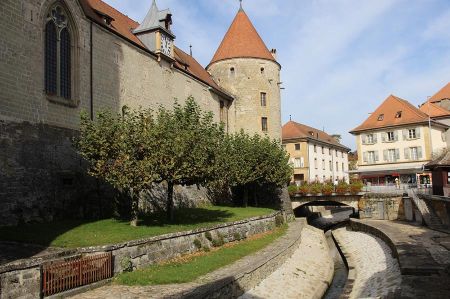Yverdon-les-Bains – holiday region on Lake Neuchâtel
- Written by Portal Editor
During our several-day stay at a campsite near Avenches and after the strenuous camping fair in Bern, we also circled Lake Neuchâtel and came across the primeval menhirs, which we have already reported on.
It goes without saying that the Romans also played a crucial role in a history spanning over 6,000 years, especially since Yverdon was already known for its thermal springs back then. Thanks to its sulphur and magnesium springs, Yverdon-les-Bains has a long tradition as a thermal health resort and centre of healing arts, as evidenced by the ruins of Roman thermal baths. Today, the modern thermal baths of Yverdon-les-Bains combine the beneficial properties of sulphur water with modern bathing facilities that were completely renovated a few years ago and an attached four-star hotel.
Old town between the Thielle and the Canal Oriental
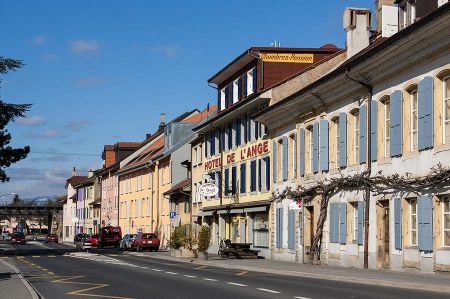 The Yverdon-les-Bains holiday region extends in the southwest of Lake Neuchâtel in the canton of Vaud at the foot of the Jura Mountains. Yverdon-les-Bains has a picturesque historic cityscape, especially in the old town. The medieval old town is located between the Thielle and the Canal Oriental.
The Yverdon-les-Bains holiday region extends in the southwest of Lake Neuchâtel in the canton of Vaud at the foot of the Jura Mountains. Yverdon-les-Bains has a picturesque historic cityscape, especially in the old town. The medieval old town is located between the Thielle and the Canal Oriental.
The approximately oval city floor plan, approximately 300 m long and 200 m wide, has a main street as its longitudinal axis, south of which there are two further longitudinal streets and several cross alleys, almost reminiscent of the founding of a Roman city.
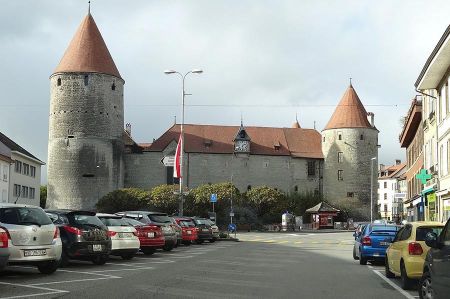 At the eastern end of the old town stands Yverdon Castle, a characteristic example of the Carré Savoyard in the form of a four-wing complex, flanked by three smaller round towers and a massive round keep at the southeast corner. In the 13th century Savoyard castle, which dominates the old town, an exhibition documents the history of the city and region.
At the eastern end of the old town stands Yverdon Castle, a characteristic example of the Carré Savoyard in the form of a four-wing complex, flanked by three smaller round towers and a massive round keep at the southeast corner. In the 13th century Savoyard castle, which dominates the old town, an exhibition documents the history of the city and region.
Since then, it has undergone numerous redesigns and restorations, especially in the residential wings. The city museum, founded in 1763, is located in the castle. Celtic artefacts, Roman boats and a sarcophagus containing the Ptolemaic mummy of Nesshou are on display here. In the Musée Suisse de la Mode, which is also located in the castle, textile treasures from the era between 1850 and 1960 are on display.
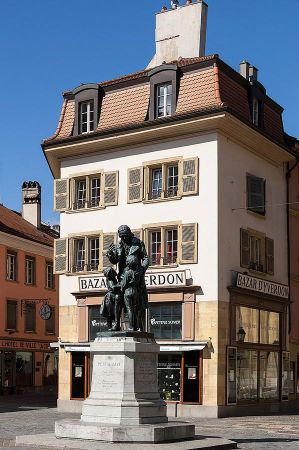 In the castle and later also in the town hall, which is worth seeing, the famous Swiss educator Johann Heinrich Pestalozzi - early influenced by Jean-Jacques Rousseau's ideas on education - ran an educational institute for poor children from 1805 to 1825 that became world famous.
In the castle and later also in the town hall, which is worth seeing, the famous Swiss educator Johann Heinrich Pestalozzi - early influenced by Jean-Jacques Rousseau's ideas on education - ran an educational institute for poor children from 1805 to 1825 that became world famous.
Also on Pestalozzi Square is the reformed church of Notre-Dame, which was built between 1753 and 1757 on the site of a previous Gothic building.
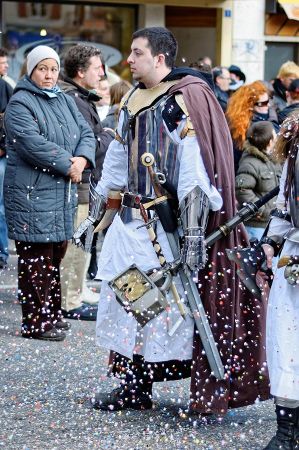 It was equipped with a striking five-axis baroque facade with a curved gable towards the square. The late Gothic bell tower (1608–1610) and the richly carved choir stalls from 1499 to 1502 were taken over from the previous building.
It was equipped with a striking five-axis baroque facade with a curved gable towards the square. The late Gothic bell tower (1608–1610) and the richly carved choir stalls from 1499 to 1502 were taken over from the previous building.
On the south side of the square, the Hôtel de ville (town hall) was built from 1767 to 1773 on the site of the former granary. It has a facade with a pilaster projection and triangular gable. Exhibitions on various topics take place here all year round. The Préfecture, the former Hôtel de l’Aigle, from 1776 also dates from the so-called Belle Epoque.
The Pestalozzi Monument from 1889 stands on Pestalozzi Square.
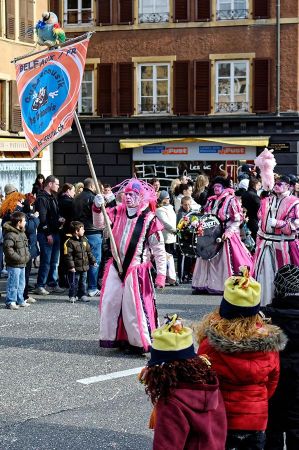 Numerous town and patrician houses from the 17th and 18th centuries have been preserved in the old town. There are also other notable buildings outside the old town: the casino built in 1898 in the neo-baroque style and the neo-renaissance schoolhouse (1897) on the other side of the Place d'Armes. The Villa d’Entremonts is a typical country estate from 1779 in the middle of a park. The classicist Catholic church of Saint-Pierre, built between 1837 and 1841, is located on Rue de la Maison-Rouge.
Numerous town and patrician houses from the 17th and 18th centuries have been preserved in the old town. There are also other notable buildings outside the old town: the casino built in 1898 in the neo-baroque style and the neo-renaissance schoolhouse (1897) on the other side of the Place d'Armes. The Villa d’Entremonts is a typical country estate from 1779 in the middle of a park. The classicist Catholic church of Saint-Pierre, built between 1837 and 1841, is located on Rue de la Maison-Rouge.
The two towns of Grandson and Romainmôtier were named two of the twelve most beautiful villages in Switzerland. Romainmôtier is dominated by its abbey church, which is one of the oldest Romanesque churches in the country and was built around the year 1000.
The southern shore of Lake Neuchâtel is a nature reserve
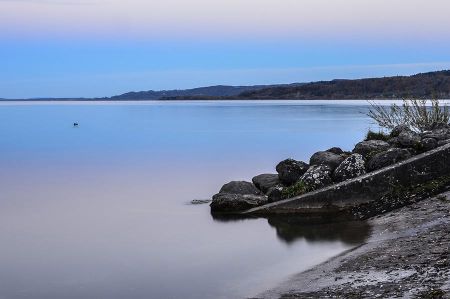 The vast nature reserve of the Grande Cariçaie stretches along the sparsely populated and sparsely developed southern shore of the lake. The country's largest wetland protected area is home to 800 plant and 10,000 animal species. You can explore the reed and reed areas of the reserve on wooden walkways without getting your feet wet. Numerous migratory birds rest here in autumn on their way south. From May to October, the natural wealth of the marshy lake shore can be discovered in the Champ-Pittet nature conservation centre in the immediate vicinity of Yverdon. Paths through moorland, forest and prairie landscapes as well as a bird watching centre enable an intensive nature experience. Numerous migratory birds rest here in autumn on their way south.
The vast nature reserve of the Grande Cariçaie stretches along the sparsely populated and sparsely developed southern shore of the lake. The country's largest wetland protected area is home to 800 plant and 10,000 animal species. You can explore the reed and reed areas of the reserve on wooden walkways without getting your feet wet. Numerous migratory birds rest here in autumn on their way south. From May to October, the natural wealth of the marshy lake shore can be discovered in the Champ-Pittet nature conservation centre in the immediate vicinity of Yverdon. Paths through moorland, forest and prairie landscapes as well as a bird watching centre enable an intensive nature experience. Numerous migratory birds rest here in autumn on their way south.
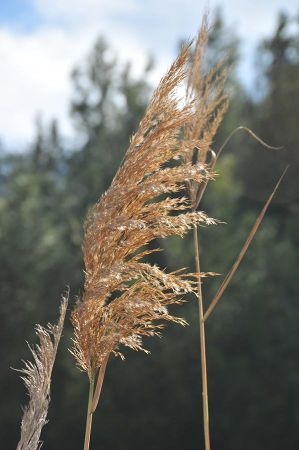 Over 280 km of hiking trails run through the Yverdon-les-Bains region. These include, for example, stages of the Jura-Höhenweg, Terra Salina, Via Francigena and Via Romana long-distance hiking trails. The four routes Castle Tour, Jura Foothills, Panorama Route and Cross Country are particularly worth experiencing for bikers. The region also invites you to enjoy water sports on Lake Neuchâtel such as sailing, surfing or swimming on the beautiful sandy beaches of Yvonand.
Over 280 km of hiking trails run through the Yverdon-les-Bains region. These include, for example, stages of the Jura-Höhenweg, Terra Salina, Via Francigena and Via Romana long-distance hiking trails. The four routes Castle Tour, Jura Foothills, Panorama Route and Cross Country are particularly worth experiencing for bikers. The region also invites you to enjoy water sports on Lake Neuchâtel such as sailing, surfing or swimming on the beautiful sandy beaches of Yvonand.
The largest stalactite caves in Switzerland can be found near Vallorbe, which experts consider to be among the most beautiful caves in all of Europe. The highlight is the 30 m high hall, also called the cathedral, in the middle of the mountain. Thanks to a special lighting concept, a unique atmosphere is created in the caves. The mineral collection, which shows 250 specimens from all over the world, is also worth seeing.
Please read as well:
